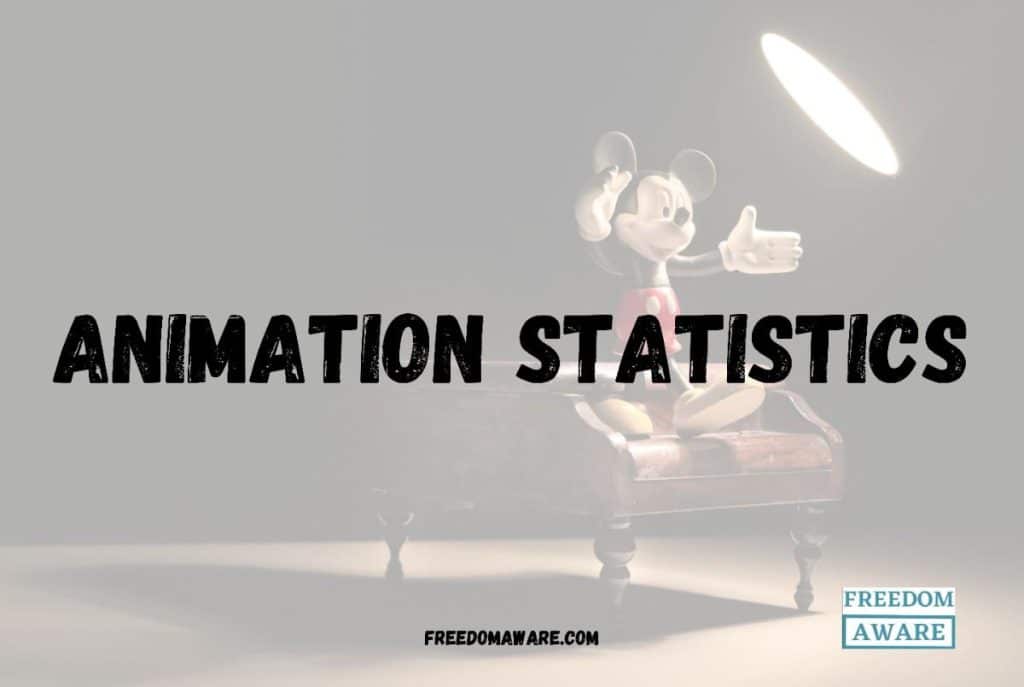
Animation statistics: Animation is truly a marvel, isn’t it?
In today’s digital landscape, animation has become an essential tool for businesses, marketers, and creators.
From the simple hand-drawn cartoons of the past to the stunning computer-generated films and series of today.
With the rise of online video content, animation statistics have become increasingly important for understanding audience engagement, behavior, and preferences.
In this article, we’ll delve into the world of animation statistics, exploring the latest trends, insights, and data-driven findings that can help you unlock the power of visual storytelling.
Key Animation Statistics (Editor’s Pick)
- South Africa leads Africa’s animation industry.
- There are currently over 4,937 animators employed in the United States.
- 92% of internet users worldwide have watched online videos, making animation a crucial aspect of online content.
- Videos are 50 times more likely to rank on the first page of Google compared to plain text content.
- The average person watches 1.5 hours of video content per day, making animation a vital tool for capturing audience attention.
- 85% of businesses use video as a marketing tool, with animation being a key component of this strategy.
- Animated videos increase conversion rates by 20%, making them an effective tool for driving sales and revenue.
- The global animation market is projected to reach $270 billion by 2025, driven by increasing demand for animated content.
- 72% of customers prefer learning about a product or service through video, making animation a key tool for customer education.
- Animated videos have a 95% retention rate, compared to 10% for text-based content.
- The average animated video is 4.5 minutes long, with shorter videos performing better on social media platforms.
- 80% of marketers say video has increased dwell time on their website, with animation playing a key role in this engagement.
General Animation Statistics
- The average age of animators is 40 years and older, with this age group representing 47% of the total population. (Source)
- A bachelor’s degree is the most common educational attainment among animators, with 74% holding this degree. Associate degrees and Master’s degrees are held by 13% and 8% of animators, respectively. (Source)
- There are currently over 4,937 animators working in the United States. (Source)

- Women make up 28.1% of the animation workforce, while men account for 71.9%. (Source)
- The majority of animators in the US identify as White (67.7%), followed by Hispanic/Latino (13.9%), Asian (7.5%), and a smaller percentage who chose not to disclose their ethnicity (5.8%). (Source)
- Animators and special effects artists in the US earn an average annual salary of approximately $99,060, according to the U.S. Bureau of Labor Statistics. (Source)
- Asian animators earn the highest average salary among all ethnicities, while Black or African American animators earn the lowest at $66,339 per year. (Source)
- Animators with advanced degrees tend to earn higher salaries, with those holding a Master’s degree averaging $87,684 per year, followed by those with a Bachelor’s degree at $85,609, and those with an Associate degree at $73,425. (Source)
- Most animators prefer working at private companies rather than public companies. (Source)
- The media, technology, and education industries are the top employers of animators. (Source)
- The global animation market is booming, with its value projected to increase from $395 billion in 2022 to $529 billion by 2030, at a steady growth rate of 5% per year. (Source)
- The global animation and visual effects market is also on a strong growth trajectory, expected to expand from $180 billion in 2024 to $311 billion by 2029, with an impressive annual growth rate of 9.43%. (Source)

- “Incredibles 2” continues to reign as the top-grossing animated film in North America, having raked in nearly $609 million in the US and Canada as of February 2024. (Source)
- The production costs of movies vary significantly, with animation films typically falling in the range of $20 million to $50 million, while live-action films can cost anywhere from $40 million to over $100 million. (Source)
- The animation market is thriving due to the rising popularity of computers and smartphones. Many businesses are leveraging animation to showcase their concepts and product models effectively. (Source)
- “Frozen 2” remains the highest-grossing Disney animated film, having earned over $1.45 billion worldwide as of January 2024, followed by its predecessor “Frozen” with $1.28 billion. (Source)
- Fully animated films, such as “The Super Mario Bros. Movie,” are among the top-grossing video game movies worldwide as of March 2024. (Source)
- “The Super Mario Bros. Movie” continues to hold the title of the highest-grossing video game adaptation, having raked in $1.36 billion globally. It has surpassed “Warcraft” and “Pokémon: Detective Pikachu” in terms of box office revenue. (Source)
- Only four animated film series have made it to the top 20 highest-grossing movie franchises worldwide as of June 2022, including “Despicable Me,” “Shrek,” “Ice Age,” and “Toy Story.” (Source)
- The global motion graphics market is experiencing significant growth, with its value projected to increase from $71.68 billion in 2022 to $177.50 billion by 2030, driven by a CAGR of 12%. This indicates a rising demand for and adoption of motion graphics. (Source)
- The high production costs associated with animation can be a significant barrier to entry for new players in the global market, hindering its growth. (Source)
- The global visual effects market is poised for growth, with its value projected to increase from $10 billion in 2023 to $18 billion by 2032, driven by a CAGR of 6.7% during the forecast period. (Source)
- Spanish is the most widely spoken foreign language among animators, with 35.3% reporting proficiency. French and Japanese are spoken by 14.0% and 8.1% of animators, respectively. (Source)
- The average animator stays in their job for one to two years. (Source)
- Animators earn the highest salaries in Nevada, where the average annual income is $130,776. (Source)
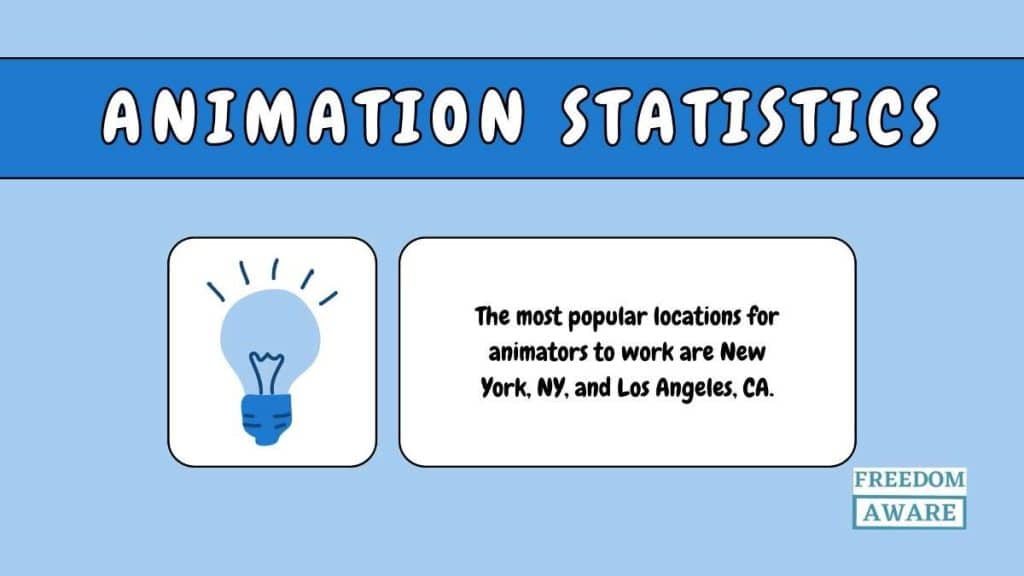
- The most popular locations for animators to work are New York, NY, and Los Angeles, CA. (Source)
- The cost of creating individual animation sequences can range from $10,000 to $60,000. (Source)
- OTT streaming services like Netflix, Amazon Prime, YouTube, Twitter, and Facebook are playing an increasingly important role in distributing animation, visual effects, and game content. (Source)
- Disney’s “Frozen” franchise has proven to be a massive financial success, generating a return on investment of nearly 9.9 times since its release in 2013. (Source)
Animation’s Growing Role in Marketing (Animation Statistics)
- Marketers from various industries are using animated content, with the highest percentage (23.8%) coming from advertising and marketing agencies, followed by education (9.9%), technology (7.5%), financial (7.9%), and e-commerce/retail (7.9%) sectors. (Source)
- A significant number of marketers, 60.8%, are using animation in their social media posts. (Source)
- To explain complex concepts in a visually appealing and understandable way, 37% of marketers are utilizing animated explainer videos. (Source)
- To make their email marketing campaigns more dynamic and engaging, 24.7% of marketers are strategically incorporating animations. (Source)
- Animated GIFs are being used by 21.6% of marketers to add visual appeal and a playful element to their overall content. (Source)
- While 9.9% of marketers consistently use animation in their campaigns, an additional 29.3% are incorporating animated elements without making them the primary focus. (Source)
2D Animation Statistics
- The market for 2D animation software is experiencing significant growth, with its value projected to increase from $35.64 billion in 2022 to $92.93 billion by 2030, driven by a CAGR of 12.73%. (Source)
- 2D Animators in the United States earn an average annual salary of approximately $62,000, which is higher than the national average. (Source)
- The film and television industry, along with the software development industry, are the main sectors employing the majority of 2D Animators. (Source)
- Job growth for animators is expected to increase by about 5% over the next decade, according to the Bureau of Labor Statistics (BLS). This projected growth rate is consistent with the national average for the same period. (Source)
- The animation field has been the leading application for 2D animation software, and this dominance is expected to continue throughout the forecast period. (Source)
- The standard version segment is the most popular type of 2D animation software. (Source)
- The growing demand for 2D animation software among small-scale independent animators is expected to drive regional expansion in the market. (Source)
3D Animation Statistics
- Visual effects (VFX) are expected to be the fastest-growing segment of the 3D animation market between 2023 and 2030. (Source)
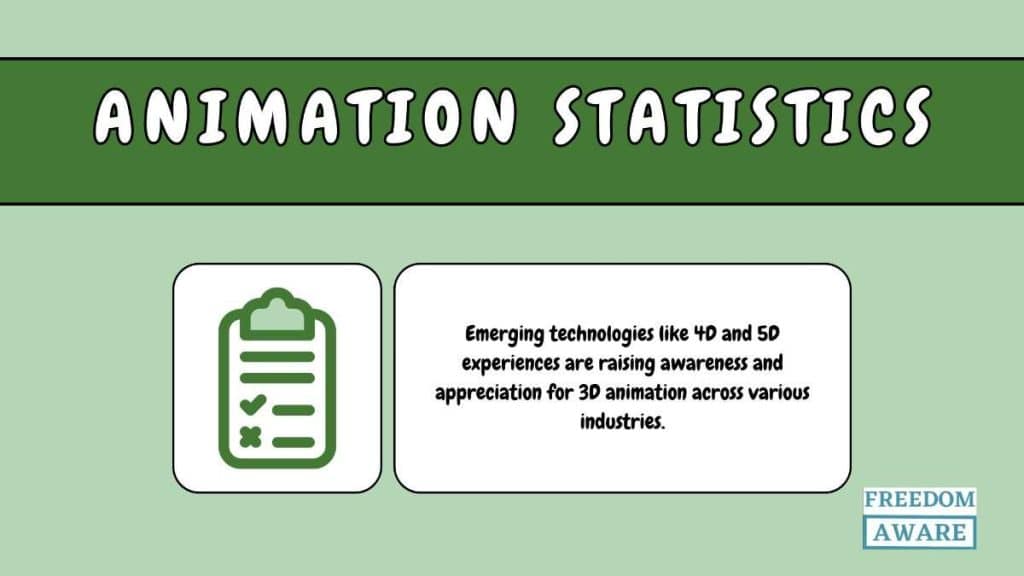
- Emerging technologies like 4D and 5D experiences are raising awareness and appreciation for 3D animation across various industries. (Source)
- 3D modeling currently holds the largest share of the market revenue and is predicted to stay in the lead throughout the forecast period. Additionally, the 3D software and hardware segments are expected to experience significant growth due to the rising demand for skilled developers and designers. (Source)
- The on-demand segment of 3D animation is projected to see the highest compound annual growth rate (CAGR) from 2023 to 2030. (Source)
- The 3D animation industry is experiencing constant innovation. Examples include Spaceblock’s launch of 3D animation packs utilizing motion capture technology in December 2023 and Adobe’s introduction of AI and 3D features in September 2023, alongside enhanced storage capabilities from Frame.io. (Source)
- The global market for 3D animation is experiencing significant growth, with its value projected to increase from $23 billion in 2023 to $63 billion by 2032, driven by a CAGR of 11.80%. (Source)
- The entertainment and media industry has recently shown a growing demand for 3D animation, with many animation studios advancing the field by integrating virtual reality. (Source)
- Almost 84% of the animation and visual effects industry uses open-source software, particularly in animation and visual effects. (Source)
- The global 3D animation modeling market is expanding, with its value projected to increase from $6.6 billion in 2022 to $7.3 billion in 2023, representing an 11% growth rate. This growth is expected to continue, surpassing $11 billion by 2026. (Source)
- The integration of AI, VR, and AR is expected to further drive the growth of the global 3D animation market. (Source)
- Technological advancements and increased affordability of 3D animation are key factors driving market growth. (Source)
- The adoption of 3D animation in e-learning platforms to enhance visual learning experiences is boosting the market. (Source)
- A 3D Digital Artist can expect a total annual salary of $89,120, with an average base salary of $82,057. Additional compensation in the form of cash bonuses, commissions, tips, and profit sharing is also possible. (Source)
- The 3D animation software market is experiencing significant growth, with its value projected to increase from $26.01 billion in 2024 to $58.64 billion by 2031, driven by a CAGR of 11.8%. (Source)
- The 3D animation market is segmented into 3D Modeling, Motion Graphics, 3D Rendering, and Visual Effects based on techniques. (Source)
- The media and entertainment sector held the largest revenue share in 2022 and is expected to maintain its dominance, driven by the widespread use of 3D and CGI in films. (Source)
AI’s Growing Role in Animation (Animation Statistics)
- The implementation of Generative AI in animation production is anticipated to result in a significant decrease of 30% in the total time and expenses associated with the production process. (Source)
- Integration of Generative AI into animation workflows can lead to a 20% increase in creative productivity for animators and artists. (Source)
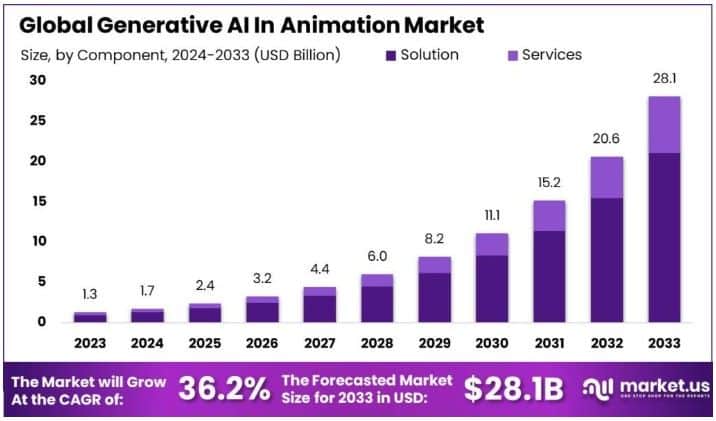
- The worldwide market for Generative AI in Animation is projected to expand significantly, reaching an estimated value of USD 28.1 billion by the year 2033. This represents a substantial increase from its value of USD 1.3 billion in 2023, with an anticipated compound annual growth rate (CAGR) of 36.2% during the forecast period spanning 2024 to 2033. (Source)
- Millennials are more likely to see AI animation as beneficial to the film and TV industries compared to GenXers, who tend to view it as harmful. A significant portion of respondents remain neutral or undecided. (Source)
- Generative AI is expected to have a significant impact on 204,000 jobs in the entertainment industry between 2023 and 2026, with 118,500 of those jobs (21.4%) being in film, TV, and animation, representing 55% of the industry’s workforce. (Source)
- The Generative AI in Animation market is expected to experience a remarkable growth rate of 35.7% annually, reaching a substantial $17.7 billion by the year 2032. This suggests a substantial and swift expansion within the industry. (Source)
- According to a recent report, more than 60% of animation studios are either actively exploring or have already begun implementing Generative AI solutions within their production pipelines. (Source)
- In the US film, TV, and animation industry, 3D modeling is the task most likely to be impacted by generative AI, with 40% of respondents using GenAI technology for character and environment design to streamline their workflow. (Source)
- A survey found that 33% of respondents expect 3D modelers to be impacted by AI in the next 3 years, while 25% believe compositors are at risk. However, only 15% think storyboarders, animators, illustrators, and look/surface/material artists will experience job displacement by 2026. (Source)
- The global market for AI animation tools is expanding significantly, with its value projected to increase from $372.84 million in 2023 to $1,311.60 million by 2032, driven by a CAGR of 15%. (Source)
- A 2023 US survey on AI-animated content found that there is a gender divide in opinions, with more females than males viewing AI animation positively. However, a significant portion of both males and females remain neutral. (Source)
Animation Statistics By Region
Asia Pacific(Animation Statistics)
- The Asia Pacific region is anticipated to exhibit one of the most rapid growth rates from 2022 to 2030, primarily due to the widespread acceptance and utilization of Generative AI in emerging economies such as China and India. (Source)
- Data Bridge Market Research forecasts the Asia-Pacific animation industry to reach $147.37 billion by 2029, driven by increased demand and technological advancements. (Source)
- OTT platforms constitute the largest animation market segment in the Asia-Pacific region. (Source)
- The rising popularity of animated films and daily serials is a key factor driving the growth of the Asia-Pacific animation market. (Source)
China
- 2021 Domestic Revenue: China’s animation industry generated $3.84 billion domestically, closely competing with Japan’s $3.22 billion. (Source)
- Top-Grossing Film: “Ne Zha” (2019) achieved domestic revenue of $737 million, accounting for 99% of its total $742 million earnings. (Source)
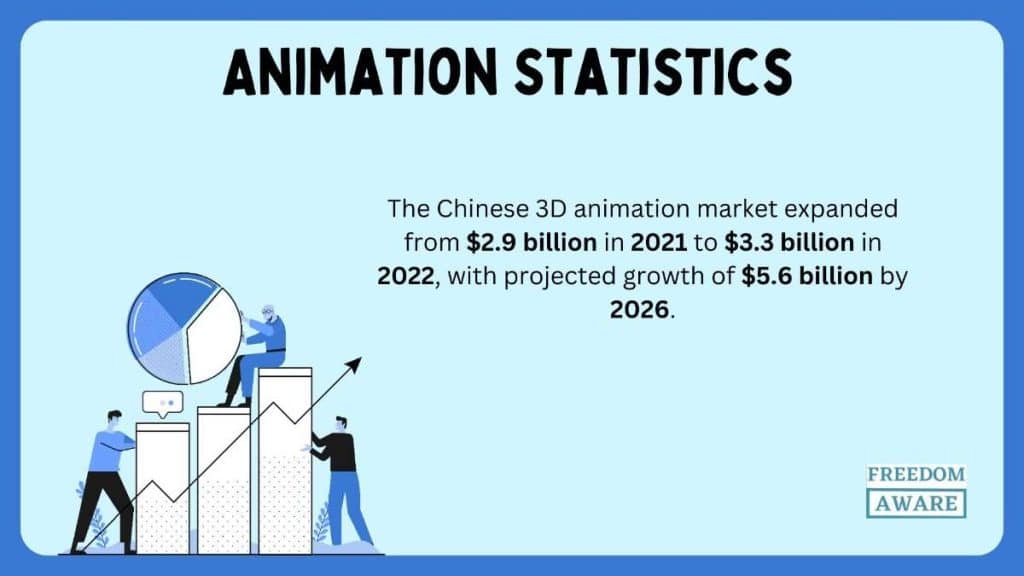
- 3D Animation Market Growth: The Chinese 3D animation market expanded from $2.9 billion in 2021 to $3.3 billion in 2022, with projected growth of $5.6 billion by 2026. (Source)
Japan
- Highest-grossing Film: “Demon Slayer: Mugen Train” (2021) generated $507 million, with 24% ($121 million) coming from international markets. (Source)
- The international market for anime reached approximately 2.93 trillion yen in the year 2022. (Source)
- “The First Slam Dunk” emerged as the most successful animated film in Japanese theaters during the year 2023, amassing a box office gross of 15.87 billion Japanese yen. (Source)
- Toei Animation Co., Ltd. generated nearly 41 billion Japanese yen in net sales through its domestic business in fiscal year 2024. During the same period, Asia emerged as the company’s second-largest market. (Source)
South Korea
- Foreign Film Success: Animated films like “Frozen” and “Aladdin” have achieved significant box-office success in South Korea. (Source)
- Industry Revenue: South Korea’s animation industry generated approximately 755.5 billion won in sales revenue in 2021, with production leading the sectors. (Source)
- The number of businesses in South Korea’s animation industry increased by 32% in 2021, reaching 647 companies. (Source)
- Science fiction/fantasy/adventure emerged as the most preferred genre by 44% of respondents, followed by comedy and drama. (Source)
- A 2023 survey revealed a divided opinion on South Korean animation’s popularity, with 26.8% considering its niche and a similar proportion believing it to be popular among the general public. (Source)
- A 2023 survey found that 21.5% of South Koreans watch animation almost daily, indicating a stable viewership habit since 2020. (Source)
- Overwhelmingly, 91% of South Koreans prefer watching animation on OTT services, followed by advertising-based platforms and movie theaters. (Source)
- A 2023 survey revealed that children visited cinemas an average of 2.7 times to watch animations in the past year, compared to the overall average of 1.7 times. (Source)
Australia
- The Australian market for 3D animation is projected to expand at a CAGR of 15% from 2024 to 2030. (Source)
- Factors driving the growth include increasing demand for high-quality 3D animation, cost-effectiveness of 3D technologies, and rapid technological advancements. (Source)
- Australia’s 3D animation sector is highly competitive, with prominent companies like Animal Logic and Alt.vfx. (Source)
- The consulting segment is anticipated to experience the highest CAGR of 13.3% from 2021 to 2026. (Source)
- Ongoing technological advancements and increased content consumption will fuel the demand for innovative animations. (Source)
- The on-demand deployment segment is expected to grow during the 2021-2026 forecast period due to its cost-efficiency. (Source)
North America
- As of mid-2022, the top-grossing animated films in North American cinema history were globally popular titles. (Source)
- As of February 2023, the top-grossing Pixar films in the US and Canada were “Incredibles 2” ($609 million), “Finding Dory” ($486 million), “Toy Story 4” ($434 million), and “Toy Story 3” ($415 million). (Source)
- The North American animation market reached USD 23.22 billion in 2023 and is projected to grow to USD 36.73 billion by 2031, with a CAGR of 5.90% from 2024 to 2031. (Source)
- North America is expected to lead the animation market due to its widespread use in various applications, the establishment of major animation studios, and increased animated game production. (Source)

- “Shrek 2” is the highest-grossing animated feature not produced or distributed by Disney in North America. The Shrek franchise is DreamWorks Animation’s most successful franchise. (Source)
- The number of people employed in Canadian animation studios is estimated to be between 4,127 and 10,494 individuals. (Source)
- Films from the Shrek franchise occupy four of the top ten highest-grossing DreamWorks Animation movies in the U.S. and Canada. (Source)
Europe
- In 2022, nearly 44% of animated film audiences in France were children aged 3 to 14. (Source)
- European TV animation co-productions account for 36% of all TV animation hours produced, a significantly higher proportion than live TV fiction. (Source)
- The share of European works in animation (21%) is notably lower than in other categories of works (33%), impacting both SVOD and TVOD platforms, especially in animation films. (Source)
- The Observatory estimates Europe’s annual production volume of TV animation to be around 220 titles, totaling 5,200 episodes and 830 hours. (Source)
- Animation holds a significant position in TV content on SVOD services, accounting for 22% of titles. (Source)
- Approximately 55 animation films and 830 hours of animation TV content are produced annually in Europe. (Source)
- The UK animation industry generated a direct GVA of £130.6 million and direct tax revenues of £74.2 million in 2019. Considering indirect benefits, the estimated GVA increases to £285.2 million, and tax revenues rise to £110.2 million. (Source)
- The UK animation industry directly employs around 1,000 skilled professionals. Additionally, it supports an additional 14,390 jobs in related industries, totaling 15,390 jobs when considering the broader value chain. (Source)
- In 2022, France witnessed the release of 52 animated films, a significant increase from the previous year’s output. (Source)
- 51% of workers in the UK animation industry are women. (Source)
Africa
- The African animation market was valued at US$13.3 billion in 2023 and is projected to reach US$17.8 billion by 2032, with a CAGR of 7.78% from 2024 to 2032. (Source)
- South Africa leads the animation industry in Africa. (Source)
- The increasing use of animated visuals in brand advertising and product promotions drives market expansion. Leading animation studios in South Africa include Triggerfish Animation Studios, Aardman Animations, and Boulder Media. (Source)
- Adopting advanced animation software with customizable characters and extensive libraries, as well as integrating virtual reality and artificial intelligence into 3D gaming platforms are key drivers of market growth. (Source)
- Israel is the dominant player in the Middle East and Africa region due to the growing demand for digital advertisements featuring animated content. (Source)
Conclusion (Animation Statistics)
The world of animation is booming, and these statistics paint a vibrant picture of its growing impact. From captivating audiences across generations to driving innovation in storytelling and technology, animation’s influence is undeniable. Understanding these trends is crucial for anyone involved in the industry, from aspiring animators to industry leaders. As technology continues to evolve and audiences demand more immersive experiences, animation’s power to inspire, entertain, and educate will only continue to grow. So, whether you’re creating your own animated masterpiece or simply an avid fan, embrace the dynamic world of animation and unlock its power to captivate and connect.

FAQ (Animation Statistics)
Is animation a successful career?
A single animation film can require the services of up to 500 animators, presenting substantial employment opportunities. Animation stands as a tangible, profitable, and challenging career path that serves both the entertainment and education (e-learning) industries.
Is animation in high demand?
The United States stands as one of the primary destinations for animation, and the demand for animators is steadily increasing across the nation. The Bureau of Labor Statistics predicts the creation of 3,200 new jobs for multimedia artists and animators in the United States between 2021 and 2031.
How is AI used in the animation industry?
AI is employed in the animation industry to automate and improve various tasks, including character and environment design, animation testing, and special effects creation, thereby increasing efficiency and realism. Furthermore, AI-powered tools can aid in tasks such as color correction, lighting, and compositing, enabling human animators to concentrate on creative decision-making and storytelling.
Which is the top animation company in the world?
Determining the top animation company in the world can be subjective and depends on various factors such as revenue, critical acclaim, cultural impact, and technological innovation.
However, some of the most renowned and consistently successful animation studios often mentioned include:
- Walt Disney Animation Studios: Known for iconic characters and timeless stories.
- Pixar Animation Studios: Renowned for their innovative storytelling and groundbreaking technology.
- DreamWorks Animation: Producing a wide range of animated films, often with a comedic or action-packed focus.
- Studio Ghibli: A Japanese animation studio celebrated for its imaginative storytelling and beautiful visuals.
- Sony Pictures Animation: Known for their diverse portfolio, including superhero films and family comedies.

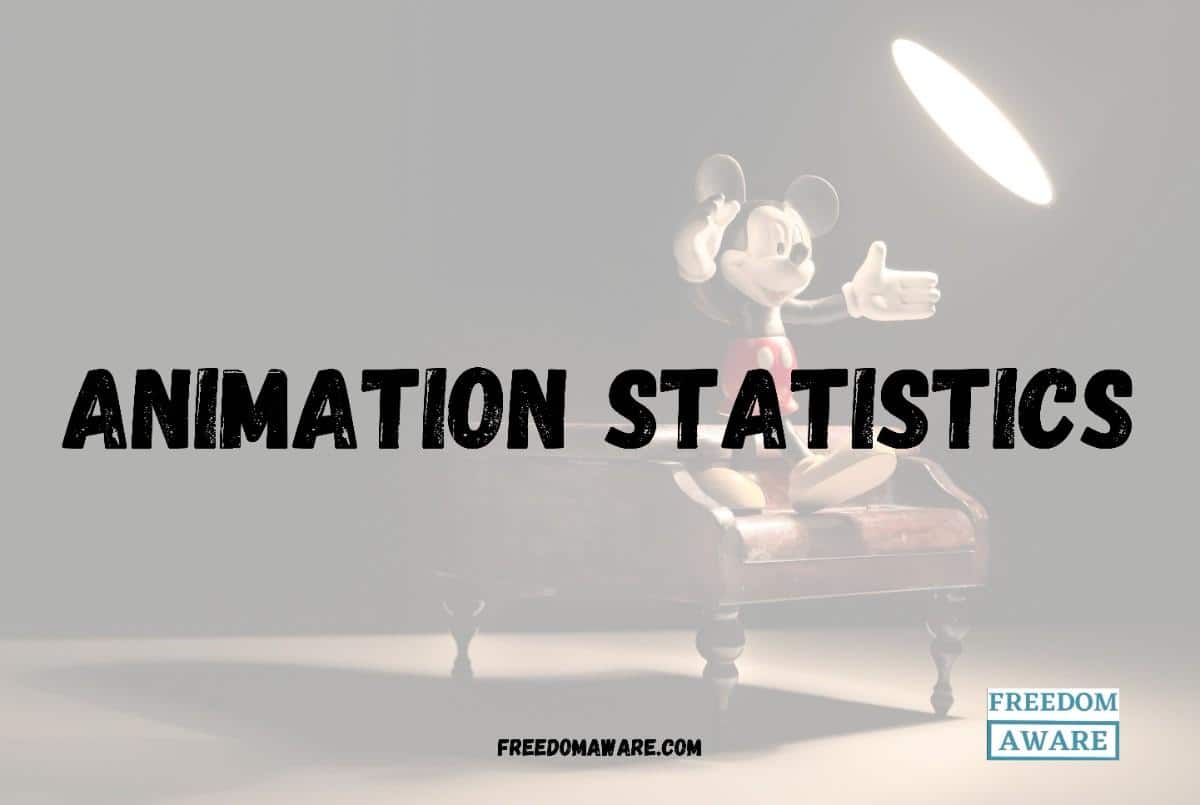
Leave a Reply